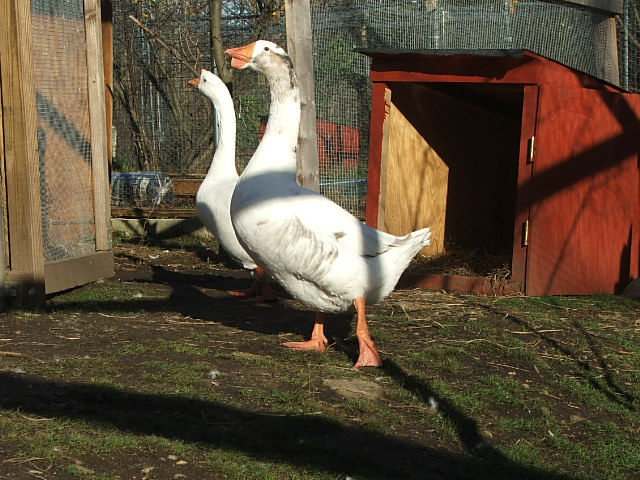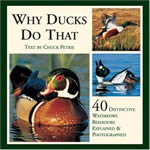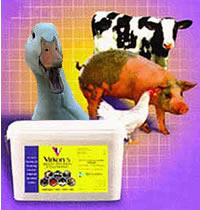|
In This Issue...
 |
Virkon S Disinfectant |
 |
Aspergillosis
|
 |
Get to Know Your Predators: Bobcat |
 |
Recommended
Reading:
Why Ducks Do That |
 |
Reader Poll #23
|
|
Get to Know
Your Predators:
Bobcat
A relative of ours recently
discovered a bobcat in their yard, local to CT in the
neighboring town of Franklin. Beware! (See photo below)

Bobcats can be
anywhere from fifteen to thirty pounds (males 20-30
pounds, females 15-25 pounds) and can jump up as high as
twelve feet. Bobcats are solitary animals who, like the
fox, are very adaptable and can live in very close
proximity with humans without being detected. If you do
come in contact with a bobcat, they can be provoked to
attack, so use extreme caution.
Motion sensing
lights around your duck pen can be helpful, but a large
guard dog can be of greater assistance if this predator
is a known trouble-maker in your area.
The Month in
Photos!

Ali & Chan
Recommended
Reading*

|
Ordering
information |
Why Ducks Do That: 40
Distinctive Duck Behaviors Explained & Photographed
By Chuck Petrie
 |
Why do
ducks make so many different sounds? |
 |
Why do
ducks have much keener vision than humans? |
 |
Why do
different species of ducks have different shapes to
their bills? |
 |
Why do
ducks rest in below-freezing weather on frigid
ponds? |
 |
Why do
ducks waddle when they walk? |
 |
Why do
ducks have new mates every year, while geese mate
for life? |
 |
Why do
ducks migrate at night |
 |
Why do
ducks fly in V formation? |
 |
Why do
ducks molt their feathers and become flightless? |
 |
Why do
ducks lay such large eggs?
|
|
* |
For
our full recommended reading list, click
here. If you order from
Amazon.com by way of our web site, Majestic receives a
portion of the proceeds!
|
Reader Poll
#23
Question: What is a
good gift to give a waterfowl lover?
Results of Reader Poll #22 Who won
the battle in the Merrie Melodies cartoon Rabbit
Seasoning? (Click
here for a plot
synopsis)
|
Bugs Bunny |
60% |
|
Daffy Duck |
20% |
|
Elmer Fudd |
20% |
|
It was a
Duck-Rabbit Tie |
0% |
|
It was a
Three-Way Draw |
0% |
Contact Us
Majestic Waterfowl
Sanctuary
17 Barker Road
Lebanon, CT 06249
directorATmajesticwaterfowl.org
Our Newsletter
The Majestic Monthly is published 12 times per year. Back
issues can be obtained online from our
Newsletter Archives.
|
|
Virkon S Disinfectant

Virkon S is a broad spectrum
disinfectant and ideal for use in your duck and goose pens, houses
and barns. It comes in powder form with its own measuring scoop. It
dissolves instantly in water, so it is easy to mix up a batch for an
instant cleaning solution. It is safe to use around your flock and
works very well in quarantine situations.
Label information:
EFFECTIVE AGAINST THE FOLLOWING PATHOGENS:
BACTERIA
Actinobacillus pleuropneumonia
Bordetella avium
Bordetella bronchiseptica
Campylobacter pyloridis
Clostridium perfringens
Dermatophilus congolensis
Escherichia coli
Fistulous withers (Poll Evil)Haemophilus somnus
Klebsiella pneumoniae
Moraxella bovis (Pink Eye)
Mycobacterium bovis
Mycoplasma gallisepticum
Mycoplasma mycoides
Pasteurella multocida
Pseudomonas aeruginosa
Pseudomonas mallei (Glanders)
Pseudomonas vulgaris
Salmonella choleraesuis
Salmonella typhimurium
Staphylococcus aureus
Staphylococcus epidermidis
Streptococcus equi (Strangles)
Streptococcus pyogenes
Streptococcus suis
Taylorella equigenitalis
Treponema hyodysenteriae
VIRUSES
Adenovirus Pneumonia
African Horse Sickness Virus
African Swine Fever Virus
Avian Influenza Virus
Avian Laryngotracheitis Virus
Bovine Adenovirus Type 4
Bovine Polyoma Virus
Bovine Pseudocowpox Virus
Bovine Viral Diarrhea Virus
Calf Rotavirus
Canine Adenovirus
Canine Coronavirus
Canine Parainfluenza Virus
Canine Parvovirus
Chicken Anemia Virus
Coital Exantherma Virus
Distemper Virus
Duck Adenovirus
Duck Enteritis Virus
Egg Drop Syndrome Adenovirus
Equine Infectious Anemia Virus (SwampFever)
Equine Arteritis Virus
Equine Herpes Virus (Type 1)
Herpes Virus Equine (Type 3)
Hog Cholera Virus
Equine Contagious Abortion Virus
Equine Papillomatosis Virus
Equine Influenza Virus (Type A)
Equine Influenza Virus (The Cough)
Feline Calicivirus
Feline Herpes Virus
Feline Infectious Peritonitis Virus
Feline Panleukopenia Virus
Feline Parvovirus
Feline Rhinotracheitis Virus
Foot and Mouth Disease Virus
Infectious Bronchitis Virus
Infectious Bursal Disease Virus
Infectious Canine Hepatitis Virus
Infectious Pancreatic Necrosis Virus
Infectious Salmon Anaemia Virus
Infective Bovine Rhinotracheitis Virus
Leptospira Canicola Virus
Maedi- Visna Virus
Marekís Disease Virus
Newcastle Disease Virus
PCV2 Virus (PMWS)
Porcine Parvovirus
Porcine Reproductive and Respiratory
Syndrome Virus (PRRS)
Pseudorabies Virus (Aujeskyís Disease)
Rotaviral Diarrhea Virus
Snakehead rhabdovirus
SV40 Virus
Swine Influenza Virus
Transmissible Gastroenteritis Virus (TGE)
Turkey Herpes Virus
Turkey Rhinotracheitis Virus
Vesicular Stomatitis Virus
FUNGI
Aspergillus fumigatus
Candida albicans
Fusarium moniliforme
Microsporum canis
Trichophyton spp. (Ringworm)
Trichophyton spp. (Mud Fever)
PLANT PATHOGENS
Alternaria solani
Botrytis cinera
Colletotrichum coccodes
Didymella bryoniae
Fusarium oxysporum
Fusarium solani
Penicillium oxalicum
Phomopsis sclerotioides
Pyrenochaeta lycoopersici
Pythium aphanidermatium
Rhizoctonia solani
Sclerotinia sclerotiorum
Thielaviopsis basicola
Verticillium dahliae
Aspergillosis
It
is not uncommon to turn over wet hay and discovery a bluish-white
mold growing underneath, especially in humid seasons. Clear your
ducks out of the area, ensure proper ventilation if youíre indoors,
and then thoroughly clean the location. Disposable face masks
(painterís mask) are commonly viewed ineffective against the tiny
mold spores, but they certainly canít hurt. Be more careful going
forward to ensure wet hay is removed promptly and bedding is kept
dry.
Avoid using mulch
or wood chips in your pens because as
these items naturally decay, they can lead to the growth of
Aspergillus fungus
right in your duck pen.
If
you discover this Aspergillus mold
growing in your
duckís food source, immediately discard all of the food, thoroughly
clean, safely disinfect and thoroughly dry contaminated containers.
Symptoms of Aspergillus may not be readily apparent in your effected
duck until the fungus has actively invaded their lungs. Respiratory
issues, lethargy and fever are some common symptoms.
If
your ducks succumb to this ailment, anti-fungal prescriptions will
need to be administered. Frequent vet visits and follow up x-rays
will be needed to closely monitor the healing of their lungs.
Are You At Risk
Too?
Although anyone can be at
risk, those most susceptible to Farmer's Lung include individuals
with compromised immunity systems and the elderly.
|